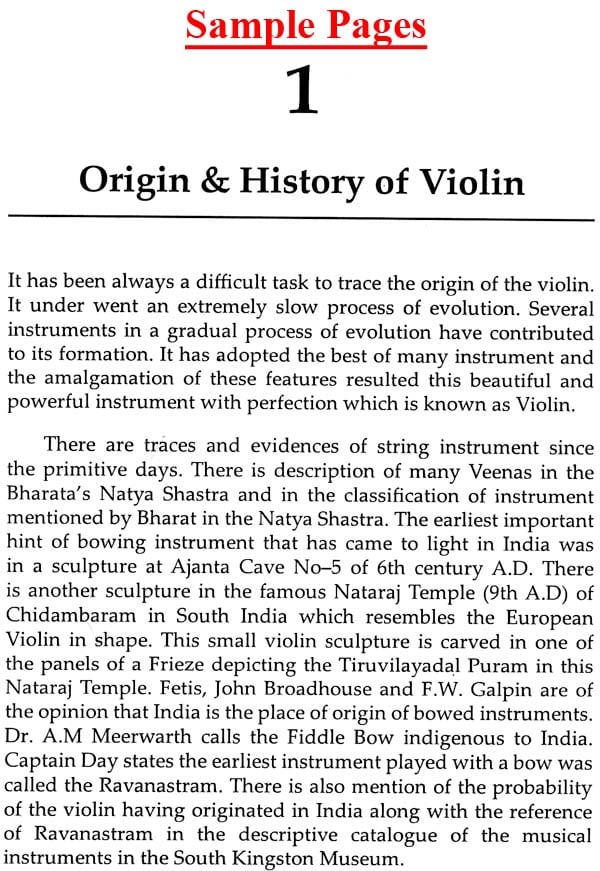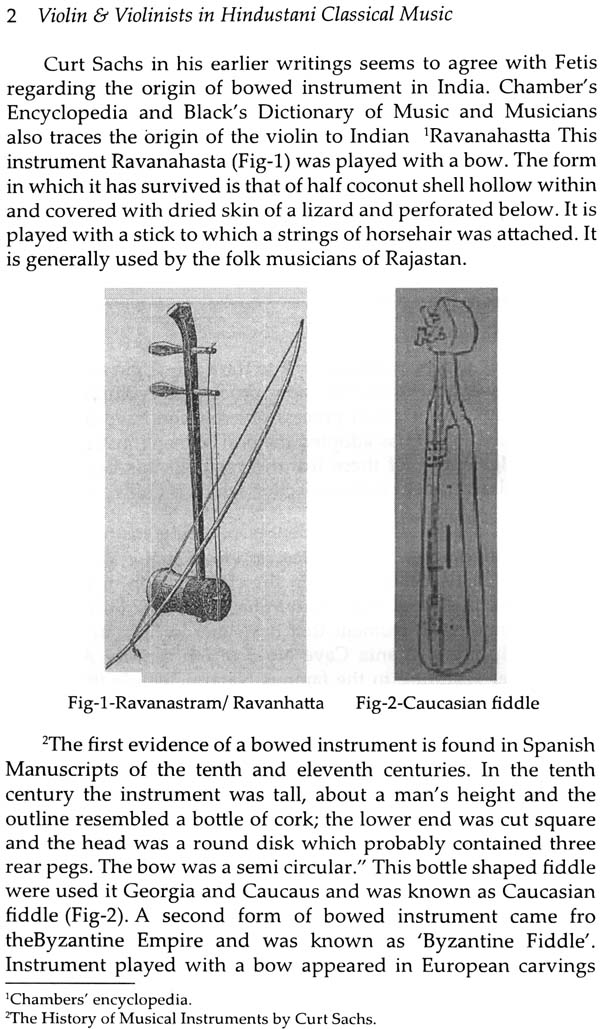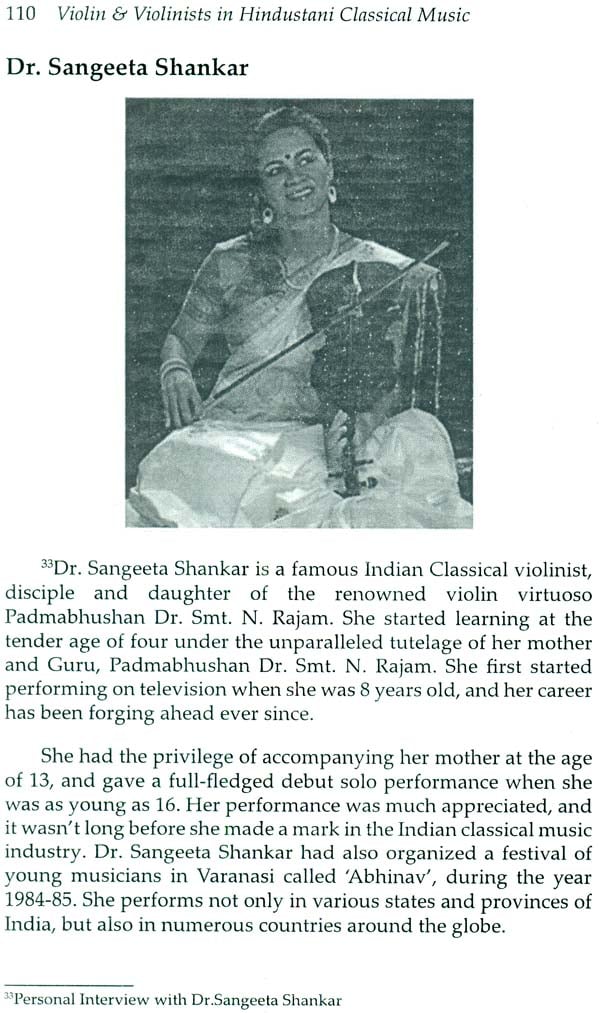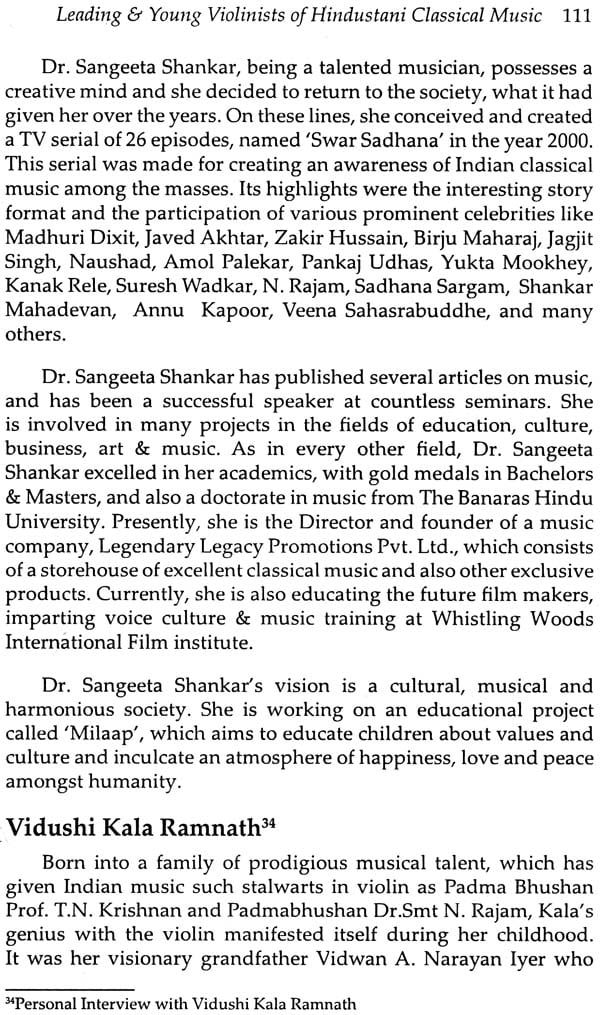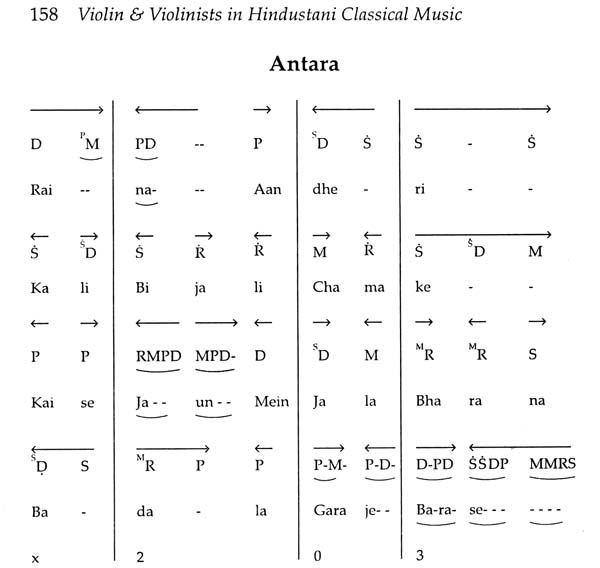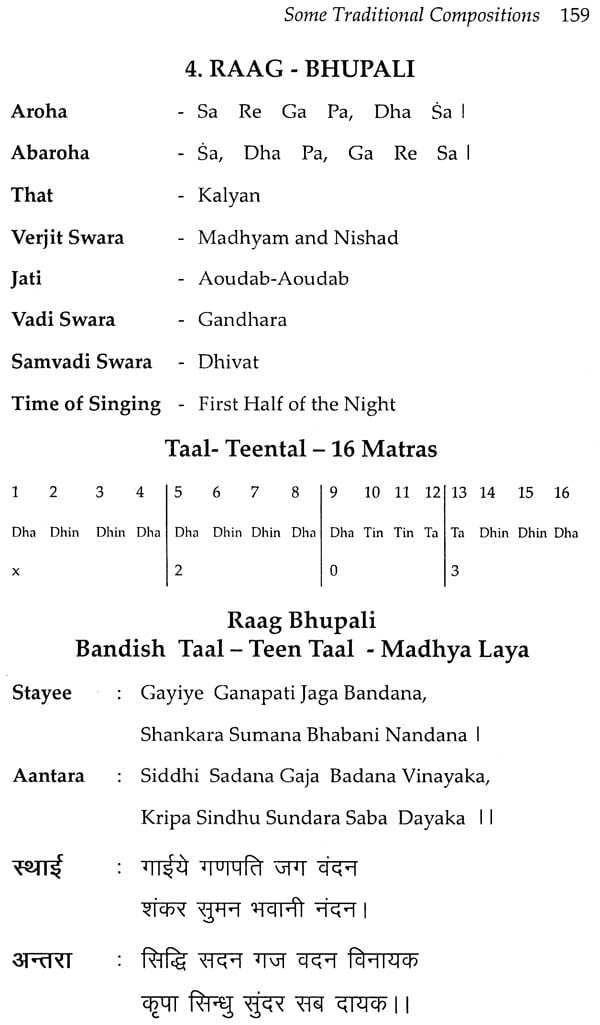
Violin & Violinists in Hindustani Classical Music
Book Specification
| Item Code: | NAO541 |
| Author: | Dr. Swarna Khuntia |
| Publisher: | Akansha Publishing House |
| Language: | English |
| Edition: | 2018 |
| ISBN: | 9788183704960 |
| Pages: | 194 (72 B/W Illustrations) |
| Cover: | Hardcover |
| Other Details | 8.5 inch X 5.5 inch |
| Weight | 380 gm |
Book Description
This is my First ever initiative to write a book with a view to keep in mind the violin students and those who love to know about violin and its technical aspect: The idea was to compile all the information regarding violin, its history, its evolution, introduction and adoption by Indian Classical music scenario, it's repertoire, it's playing techniques, the stalwarts in the field and their contribution and the various experimentations that have been undergoing in the present time, and to make it available to the students. I had faced the difficulty to find such information in one place in my student career. Violin as an Instrument travelled all the way from Europe to India way back in early 17th century during the British rule. Violin although remained unchanged as far as its structure is concerned but a lot of changes have been made as far as its playing techniques, its holding position, its handling, its repertoire, keeping in mind the versatility of the sound quality of this very perfect instrument which is very close to the human voice. Violin was first accepted and adopted by the musicians from south India and they started using it as an accompanying instrument with Carnatic music. Later it was adopted by the Hindustani classical musicians almost 100 years back. Initially it was played by imitating the Instrumental style as it used to be played in other string instruments like Sitar, Sarode and this style was popularly known as Gatkari style until Dr. Smt N. Rajam created history by introducing the Gayaki Ang in Violin playing in which she has proved that each and every vocal style like Dhrupad, Khayal, Tappa, Thumri, Kajri, Chaiti, Bhajan etc can be played with proficiency with a very fine scientific techniques of violin playing. In this book I have tried to throw light on the Gayaki Ang and also tried to cover all the stalwarts in the field of Violin in Hindustani Classical violin along with the young violinists of Hindustani classical music from the length and breadth of the country who have given their squirrel effort to popularize this instrument and contributed their bit. I sincerely hope that this work of mine will be of some help for researcher, students and also those who love this instrument.
Dr. Swarna Khuntia hails from a family of musicians from Cuttack, Odisha. A Science Graduate from Utkal University, Odisha, did her Bachelor of Music, Master of Music and Doctor of Music( D.Mus) under the able guidance of the illustrious Violinist of India who is a pioneer in "GAYAKI ANG" of Violin playing, Padmabhushan Dr.Smt. N. Rajam from prestigious Faculty of Performing Arts, Banarais Hindu University in 1993,1995 & 1997 respectively. She has received the National Cultural Scholarship from HRD, Deptt. of Culture, Govt. of India in 1993, Fellowship from Orissa Sangeet Natak Academi in 1995 under Dr. Rajam and Junior Research Fellowship from HRD, Govt. of India for the year 1998 —2000. As a Graded Artist of All India Radio and Doordarshan and recipient of Sur-Mani Title from Sur Singar Samsad, "Kalashree" title from Jharial Mahotsav Odisha, and "Laya Jyoti" from New Delhi, she has performed Solo Violin Concerts in USA, France, Nepal, Sri Lanka and in Various cities of India. Since November 2006 Dr. Swarna has been working as an Assistant Professor in Violin at the Department of Instrumental Music, Faculty of Performing Arts, Banaras Hindu University,Varanasi, U.P. Earlier she has also worked as a Lecturer in violin at Indira Kala Sangeet University, Khairagarh, Chhattishgarh.
I am happy that my disciple, Dr. Swarna Khuntia, has undertaken to write a book on violin entitled 'Violin and Violinists in Hindustani Classical Music'. It is the intense desire to delve deep into the diverse and intriguing aspects of the violin pertaining to its history, evolution, structure, its makers and their passion for this instrument, the practitioners of violin in different genres and making them available at one place for all students of violin that prompted her to attempt this laudable venture.
I understand that she proposes to address the following issues related to the instrument in the different chapters of her book, namely, the origin and history of violin; its gradual evolution; its makers; structure and different parts of the violin; evolution of bow - the inseparable part of the violin; its acoustics; its journey from Europe to India and its adoption in the Carnatic and Hindustani systems of Indian music; the various styles of playing the instrument in India with special reference to Gayaki Ang; the role and contributions of eminent and leading violinists of Hindustani Music; and younger generation of violinists and so on.
The information contained herein, will no doubt be of great use to all connected with violin. Dr. Khuntia is passionate about her subject and is hardworking by nature. I'm confident that she would be able to achieve her intended objective mainly providing all information about the instrument at one place for the benefit of all future violin students. I wish her endeavour all success.
The idea of this book was born the very day on which I had to change the tuning of my Violin from mandra Pa —Sa —Pa — Sa (Tara) to the Mandra Sa — Pa — Sa — Pa. Being a serious student and having a science background whole lot of questions came to my mind. Why these sorts of differences in our music system (Hindustani Classical Music) persist which confuse the student, why one is compelled to change the techniques when he/she has to change a guru. To some extent this is not the case in western music system as far as violin is concerned. They have certain techniques which are followed by everyone. Similar is the case in South India, as they have got a set technical approach as far as violin teaching is concerned and one can feel the uniformity to a great extent. Apart from this, many more questions bothered me for quite some time and perhaps I am still in search of their answers.
I was not prepared to accept the change mentally and to be honest I have experienced a lot of difficulties for this change and the mental trauma continued up to six months until I was fully accustomed to the new tuning and technique of violin playing. Well after that there is no looking back for me and I have emerged as a confident student of violin. Thanks to my guru Padmashree Dr. Smt. N. Rajam who guided me patiently and encouraged me all the time till today. Whatever I am today, it's only because of her blessings. My words will be inadequate to embody the sense of gratitude that I feel from the bottom of my heart towards her whose timely guidance and superior knowledge have all along been available to me when ever I was in need. I wish her good health all throughout. Violin the smallest but the most important member of violin family which has managed to make an important place in the heart of millions of music practitioners, composers and music lovers and has earned a very respectable position like "King of instruments" because of its inherent quality as far as sound is concerned. The beauty of its elegant perfect structure has always fascinated me. Its a pleasure to know more about this amazing instrument, regarding its evolution, structure, its makers and their passion towards this instrument and many more such qualities associated with this instrument.
This is my First ever initiative to write this book "Violin and Violinists in Hindustani Classical Music" is nothing but an extension of my experience and romance with this amazing instrument Violin with which I have spend the major part and percentage of my quality time for the last twenty seven years and still I am trying to understand this mysterious instrument, as every day it gives me surprises and challenges but never the less my love for it is getting deeper and deeper with the time. Keeping in mind to the violin students and those who love to know about violin and its technical aspect I had started this work. The idea was to compile all the information regarding violin, its history, its evolution, introduction and adoption by Indian Classical music scenario, it's repertoire, it's playing techniques, the stalwarts in the field and their contribution and the various experimentations that have been undergoing in the present time, and to make it available to the students. I had faced the difficulty to find such information in one place in my student career.
Violin as an Instrument travelled all the way from Europe to India way back in early 17th century during the British rule. Violin although remained unchanged as far as its structure is concerned but a lot of changes have been made as far as its playing techniques, its holding position, its handling, its repertoire, keeping in mind the versatility of the sound quality of this very perfect instrument which is very close to the human voice. Violin was first accepted and adopted by the musicians from south India and they started using it as an accompanying instrument with Carnatic music. Later it was adopted by the Hindustani classical musicians almost 100 years back. Initially it was played by imitating the Instrumental style as it used to be played in other string instruments like Sitar, Sarode and this style was popularly known as Gatkari style until
Dr. Smt N. Rajam created history by introducing the Gayaki Ang in Violin playing in which she has proved that each and every vocal style like Dhrupad, Khayal, Tappa, Thumri, Kajri, Chaiti, Bhajan etc can be played with proficiency with a very fine scientific techniques of violin playing. In this book I have tried to throw light on the Gayaki Ang and also tried to cover all the stalwarts in the field of Violin in Hindustani Classical violin along with the young violinists of Hindustani classical music from the length and breadth of the country who have given their squirrel effort to popularize this instrument and contributed their bit. I sincerely hope that this work of mine will be of some help for researcher, students and also those who love this instrument.
Chapter One
is about the Origin & History of Violin where I have tried to find out the historical evolution of bowed instruments with a special reference to evolution of violin which took place in Europe in early 16th Century.
Chapter Two deals with the leading makers of violin. The violin was created during the first half of the 16th century in the region between Brescia and Cremona, in the Italian province of Lombardy. For centuries many historians and experts argued as to who invented violin whether Gasparo da salo or Andrea Amati. There were various opinions regarding different manufacturers and their stylistic approach which has been carefully discussed in this chapter.
Chapter Three deals with the structure of violin, its different parts and their importance and role in the sound production. The violin simply gives an appearance of deceptive simplicity to the eye, but in fact it is constructed with some 70 odd parts, and cutting and essembly of these parts requires the skill of a mastered craftsman. Acoustically violin is one of the most complex instruments.
Chapter Four is about the evolution of violin bow, its structure and its leading bow makers. The development of violin made new demands on the existing bow of the sixteenth century although bow has a far longer history than the violin. The modern bow evolved in response to the musical changes, which were taking place all over Europe, and this chapter throws light on the various aspects of it.
Chapter Five is about the acoustics of violin. The twentieth century has witnessed a great deal of scientific advancement in the entire world and study of acoustics of musical instruments has fascinated the physics around the globe. Violin being the most popular instrument and having a rich sound has fascinated and attracted the scientists around the globe for such a study.
Chapter Six deals with the story behind the journey of Violin from Europe to India and its adoption by Indian Classical Music in both the styles : South Indian (Carnatic) and North Indian or Hindustani Classical Music.
Chapter Seven entirely deals with the playing styles and techniques that are prevalent in Hindustani classical music with a special emphasis on the Gayaki Ang of Violin playing.
Chapter Eight is about the leading violinists of Hindustani Classical Music Scenario and their major contribution in popularizing the instrument in the field of music. Here apart from leading violinist I have tried to cover the young violinists from length and breadth of the country who are trying their level best to contribute and keeping these arts alive for our future generations to come.
Chapter Nine is about various essential factors that are important for a violin student to keep in mind, it throws light on the care and maintenance of the instrument and it gives tips for both, students and teachers, to deal with various factors that arise during the course of teaching and learning process. In Chapter Ten I have tried to give some popular gayaki Ang bandish for the benefit of the students keeping in mind the lyrics of the bandish.
Contents
| Foreword | vii | |
| Preface | ix | |
| Fingering & National used | xv | |
| 1 | Origin & History of Violin | 1 |
| 2 | Leading Makers of Violin | 8 |
| 3 | Structure of Violin | 17 |
| 4 | Structure Development of Violin Bow & Leading Makers | 33 |
| 5 | Acoustics of Violin | 41 |
| 6 | Introduction of Violin to Indian Music | 45 |
| 7 | Playing Styles and Techniques of Violin in Hindustani classical Music | 52 |
| 8 | Leading & Young Violinists of Hindustani Classical Music | 68 |
| 9 | Tips for Teachings and Learning Violin and Its Care and Maintenance | 139 |
| 10 | Few Gayaki Compositions Played in Violin | 151 |
| Bibliography | 173 | |
| Glossary of Terms used in Indian Classical Music | 176 |
